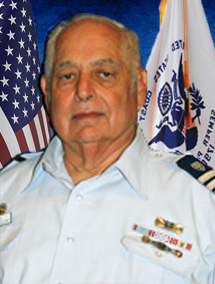PREVENTION – OUR CORE MISSION
In 1939 Congress established a U.S. Coast Guard Reserve consisting of unpaid, volunteer, U.S. Citizens who owned motorboats or yachts. In 1941, Congress created a military Reserve and renamed the original volunteer Reserve as the Coast Guard Auxiliary. One of the original purposes of the Auxiliary was “To promote safety and to effect rescues on and over the high seas and navigable waters.” This principal hasn’t changed and, as repeated in the Act of September 30, 1944, Chapter 453, 58 Stat. 759, “The primary purpose of the establishment of the Coast Guard Auxiliary was to indoctrinate all owners and operators of small craft in safety requirements in the operation and navigation of small craft.” It is to this purpose that the Directorate of Prevention exists. The goals of this directorate are to reduce deaths, injuries and loss of property, in other words, “preventative SAR’s.”
Phil Goodman, DSO-MS, heads the Marine Safety group, which includes commercial vessel activity, America’s Waterway Watch Program, and assisting the Coast Guard in oil and chemical spills, inspections, harbor patrols, and helps public education including the Sea Partner’s program.
Traveling on the water is much different than on the land. The “roads” change and markers are moved or destroyed. Assisting the Coast Guard in helping to certify and verify aids to navigation is Agnes Mical, DSO-NS. The group also includes assisting the National Ocean Service (NOS) and the U.S. Army Corps of Engineers in updating nautical and aeronautical charts. Support is given to bridge surveys and administration
It is imperative that the boating public knows how to boat safely. Without education, the boater would not know the rules for safety and what is needed. Bruce Lindsey, DSO-PE, leads the group which provides this education to the public and ensures quality instructors to deliver the information
It is necessary for all boaters to have sufficient and appropriate equipment on their vessel for safety and emergencies. Chuck Kelemen, DSO-VE, organizes this group. In addition to examining the vessels, the examiner, on a one-to-one basis, educates the boater and encourages the boater to take more education courses.
The public needs to know how we can help them. Ronald Foreman, DSO-PV, organizes a group to both educate the public and distribute literature the boater sees at displays. Boaters can pick up the literature and contact the Auxiliary for further action. Close relationship of the Program Visitor with the boat dealers gives the dealer the knowledge of our activities and communicates that information to the boaters.
No individual knows how to function as above without training. Al Crothers, DSO-MT, coordinates the desires and background of the Auxiliarist with the needs of the boaters to educate them in the areas above to result in a safe, educated, well-equipped certified member to execute successful missions.
Bill Griswold, DSO-SL coordinates our activities with those of the state. Of course, with several states and areas to cover by the Seventh District, he has members in those areas to assist. Not only should we educate and equip the boater, but it must be in compliance with the local laws.
Boat responsibly and safely,
Lawrence S. Berman
District Directorate Chief – Prevention (DDC-P)
Marine Safety, Member Training, Program Visitation, Public Education, State Liaison, Vessel Examiner & Navigational Systems


